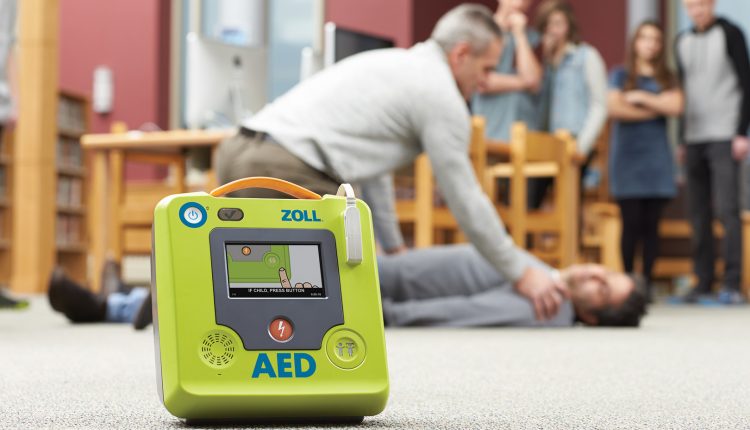
What is the AED and where to find it: some information for the citizen
The AED is an important part of the chain of survival, as it can restore normal heart rhythm in victims of sudden cardiac arrest
What is an AED?
An automatic external defibrillator (AED) is a portable life-saving device designed to treat people suffering cardiac arrest.
Cardiac arrest is a condition in which the heart suddenly (and unexpectedly) stops beating.
The AED system includes all the necessary accessories, such as electrode pads and batteries, to be able to detect and interpret an electrocardiogram.
After applying the electrode pads to the bare chest of a person who has lost consciousness, is unresponsive and is not breathing normally, the device automatically detects whether an electric shock is needed to restore the normal rhythm of the heart.
Roughly speaking, we can say that there are two main types of AED: one for public access and one for professional use
AEDs for public access are often placed in airports, schools, universities, community centres, government buildings, hospitals and other public places.
They are intended for use by people who have received basic training in first aid and cardiopulmonary resuscitation.
AEDs for professional use are mainly used by first responders, such as paramedics and emergency medical technicians (EMTs), who receive additional training.
Here is a step-by-step guide on how to operate the AED device; in an emergency, a few basics can be important:
- Start by turning on the device and following the voice instructions. Some AED models switch on automatically when the covers are opened.
- Place two electrodes (or adhesive pads with sensors) on the person’s chest.
- The electrode pads send information about the person’s heart rhythm to a processor inside the device. The AED system then analyses the rhythm to determine whether an electric shock is needed.
- If a defibrillation shock is needed, the device will use a voice or visual message to indicate when to press a button to deliver the shock. Some devices have built-in messages that announce when a shock will be delivered, even without user intervention.
- The use of the AED, together with the performance of CPR, should occur within minutes of suspected out-of-hospital cardiac arrest (OHCA). This allows for a double or triple chance of survival.
- Bystanders and rescuers have only a few moments to assess the situation and begin the steps in the cardiac arrest or survival chain.
In those moments, it is important that they get their hands on the life-saving equipment they need, namely an AED.
CARDIOPROTECTION AND CARDIOPULMONARY RESUSCITATION? VISIT THE EMD112 BOOTH
How to find AEDs
Legislation varies depending on the country you are in, but defibrillators are usually placed in large public areas, such as:
- Schools – office, staff room, university gymnasium
- Community centres – foyer or main entrance
- Hospitals – the nearest nursing stations or hospital wings.
- Commercial buildings – at ground level, close to escape and evacuation routes
- Sports clubs – golf, football, football, swimming, hockey and cricket clubs, mostly in meeting rooms
- Gyms – hung and signed on walls near equipment
- Shopping centres and malls – guest services and public toilets
- Public libraries – main entrance
- Zoos – reception and staff room
It would also be a good idea to add CPR face masks, non-latex protective masks, safety razors (for shaving chest hair), absorbent towels and a first aid kit near the location of the AED in these places.
Learn what AEDs are
AEDs are life-saving devices that are easy to use, but proper training by a qualified and reliable trainer is recommended.
Many organisations offer AED training courses (in connection with the CPR course).
Formal training in CPR and AED will teach you how to recognise the signs of cardiac arrest, how to call emergency services, how to perform CPR and how to use an AED.
Many misconceptions about this device prevent people from using it.
However, with proper training and confidence, it is possible to lengthen the time it takes for help to arrive and ultimately save a person’s life.
The best way to be prepared is to commit to and maintain an up-to-date CPR certificate.
The more bystanders who know what to do in an emergency, the greater the chances of surviving a cardiac arrest.
It is never too late to learn CPR and the correct use of the defibrillator.
Read Also:
Emergency Live Even More…Live: Download The New Free App Of Your Newspaper For IOS And Android
‘D’ For Deads, ‘C’ For Cardioversion! – Defibrillation And Fibrillation In Paediatric Patients
Inflammations Of The Heart: What Are The Causes Of Pericarditis?
Do You Have Episodes Of Sudden Tachycardia? You May Suffer From Wolff-Parkinson-White Syndrome (WPW)
Knowing Thrombosis To Intervene On The Blood Clot
Patient Procedures: What Is External Electrical Cardioversion?
Increasing The Workforce Of EMS, Training Laypeople In Using AED
Difference Between Spontaneous, Electrical And Pharmacological Cardioversion
What Is A Cardioverter? Implantable Defibrillator Overview
Defibrillators: What Is The Right Position For AED Pads?
When To Use The Defibrillator? Let’s Discover The Shockable Rhythms
Defibrillator Maintenance: What To Do To Comply



